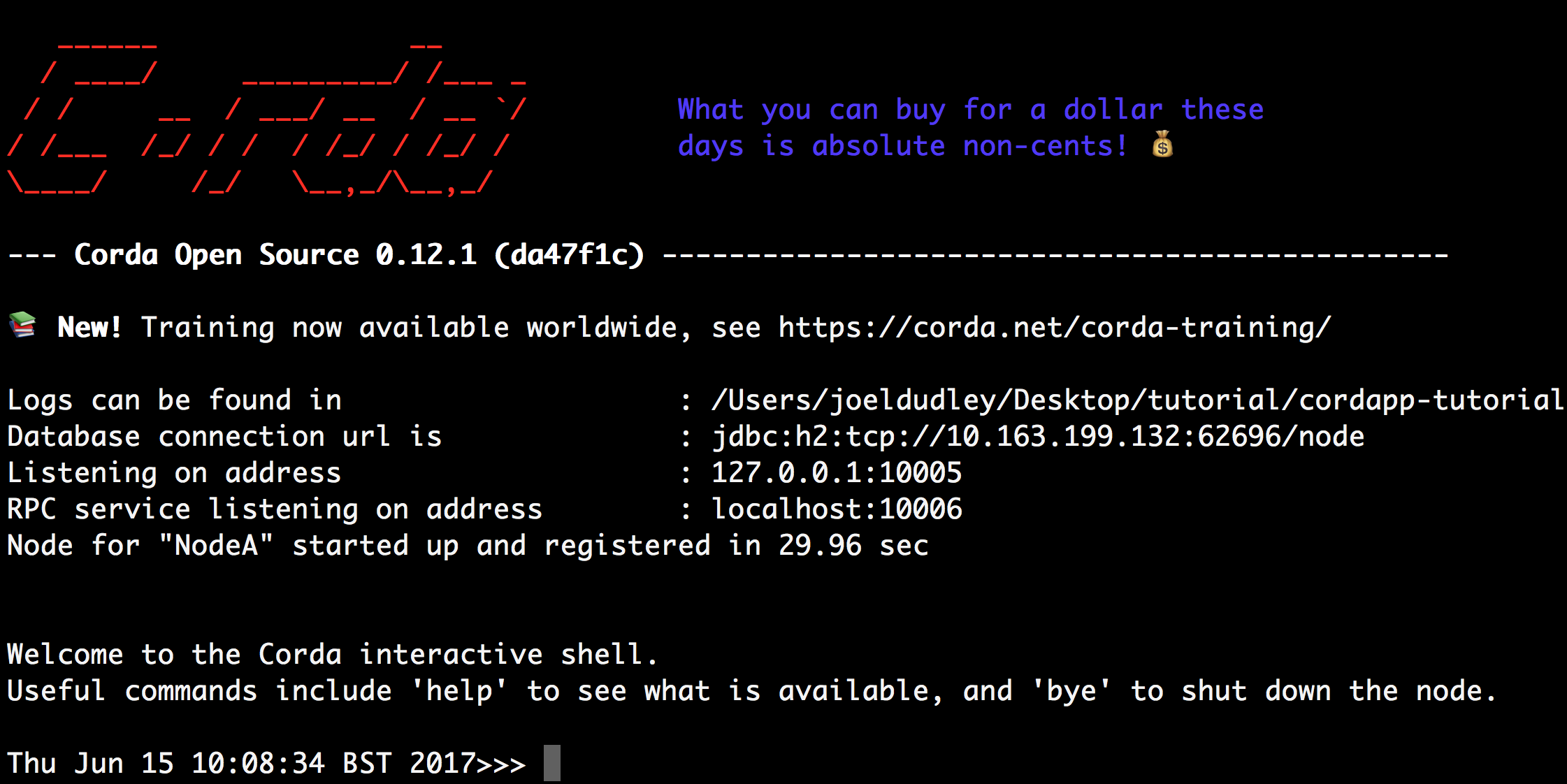The remaining use for it was the finance CorDapp for permissioning CCY issuers. Instead this is now taken from a custom config in node.conf.
7.7 KiB
Running our CorDapp
Now that we've written a CorDapp, it's time to test it by running it on some real Corda nodes.
Clean up
Before running our node, delete the client/TemplateClient.java (for Java) or client/TemplateClient.kt (for Kotlin) file. We won't be using it, and it will cause build errors unless we remove it.
Deploying our CorDapp
Let's take a look at the nodes we're going to deploy. Open the project's build.gradle file and scroll down to the task deployNodes section. This section defines three nodes - the Controller, NodeA, and NodeB:
task deployNodes(type: net.corda.plugins.Cordform, dependsOn: ['jar']) {
directory "./build/nodes"
networkMap "O=Controller,L=London,C=GB"
node {
name "O=Controller,L=London,C=GB"
notary = [validating : true]
p2pPort 10002
rpcPort 10003
cordapps = ["net.corda:corda-finance:$corda_release_version"]
}
node {
name "O=PartyA,L=London,C=GB"
p2pPort 10005
rpcPort 10006
webPort 10007
cordapps = ["net.corda:corda-finance:$corda_release_version"]
rpcUsers = [[ user: "user1", "password": "test", "permissions": []]]
}
node {
name "O=PartyB,L=New York,C=US"
p2pPort 10008
rpcPort 10009
webPort 10010
cordapps = ["net.corda:corda-finance:$corda_release_version"]
rpcUsers = [[ user: "user1", "password": "test", "permissions": []]]
}
}We have three standard nodes, plus a special Controller node that is running the network map service, and is also advertising a validating notary service. Feel free to add additional node definitions here to expand the size of the test network.
We can run this deployNodes task using Gradle. For each node definition, Gradle will:
- Package the project's source files into a CorDapp jar
- Create a new node in
build/nodeswith our CorDapp already installed
We can do that now by running the following commands from the root of the project:
// On Windows
gradlew clean deployNodes
// On Mac
./gradlew clean deployNodesRunning the nodes
Running deployNodes will build the nodes under build/nodes. If we navigate to one of these folders, we'll see the three node folders. Each node folder has the following structure:
. |____corda.jar // The runnable node |____corda-webserver.jar // The node's webserver |____dependencies |____node.conf // The node's configuration file |____plugins |____java/kotlin-source-0.1.jar // Our IOU CorDapp
Let's start the nodes by running the following commands from the root of the project:
// On Windows
build/nodes/runnodes.bat
// On Mac
build/nodes/runnodesThis will start a terminal window for each node, and an additional terminal window for each node's webserver - eight terminal windows in all. Give each node a moment to start - you'll know it's ready when its terminal windows displays the message, "Welcome to the Corda interactive shell.".
Interacting with the nodes
Now that our nodes are running, let's order one of them to create an IOU by kicking off our IOUFlow. In a larger app, we'd generally provide a web API sitting on top of our node. Here, for simplicity, we'll be interacting with the node via its built-in CRaSH shell.
Go to the terminal window displaying the CRaSH shell of PartyA. Typing help will display a list of the available commands.
We want to create an IOU of 100 with PartyB. We start the IOUFlow by typing:
start IOUFlow iouValue: 99, otherParty: "O=PartyB,L=New York,C=US"PartyA and PartyB will automatically agree an IOU. If the flow worked, it should have led to the recording of a new IOU in the vaults of both PartyA and PartyB.
We can check the flow has worked by using an RPC operation to check the contents of each node's vault. Typing run will display a list of the available commands. We can examine the contents of a node's vault by running:
run vaultQuery contractStateType: com.template.state.IOUStaterun vaultQuery contractStateType: com.template.IOUStateThe vaults of PartyA and PartyB should both display the following output:
states:
- state:
data:
value: 99
lender: "C=GB,L=London,O=PartyA"
borrower: "C=US,L=New York,O=PartyB"
participants:
- "C=GB,L=London,O=PartyA"
- "C=US,L=New York,O=PartyB"
contract: "com.template.contract.IOUContract"
notary: "C=GB,L=London,O=Controller,CN=corda.notary.validating"
encumbrance: null
constraint:
attachmentId: "F578320232CAB87BB1E919F3E5DB9D81B7346F9D7EA6D9155DC0F7BA8E472552"
ref:
txhash: "5CED068E790A347B0DD1C6BB5B2B463406807F95E080037208627565E6A2103B"
index: 0
statesMetadata:
- ref:
txhash: "5CED068E790A347B0DD1C6BB5B2B463406807F95E080037208627565E6A2103B"
index: 0
contractStateClassName: "com.template.state.IOUState"
recordedTime: 1506415268.875000000
consumedTime: null
status: "UNCONSUMED"
notary: "C=GB,L=London,O=Controller,CN=corda.notary.validating"
lockId: null
lockUpdateTime: 1506415269.548000000
totalStatesAvailable: -1
stateTypes: "UNCONSUMED"
otherResults: []Conclusion
We have written a simple CorDapp that allows IOUs to be issued onto the ledger. Like all CorDapps, our CorDapp is made up of three key parts:
- The
IOUState, representing IOUs on the ledger - The
IOUContract, controlling the evolution of IOUs over time - The
IOUFlow, orchestrating the process of agreeing the creation of an IOU on-ledger
Together, these three parts completely determine how IOUs are created and evolved on the ledger.
Next steps
There are a number of improvements we could make to this CorDapp:
- We could require signatures from the lender as well the borrower, to give both parties a say in the creation of a new
IOUState - We should add unit tests, using the contract-test and flow-test frameworks
- We should change
IOUState.valuefrom an integer to a proper amount of a given currency - We could add an API, to make it easier to interact with the CorDapp
We will explore some of these improvements in future tutorials. But you should now be ready to develop your own CorDapps. There's a more fleshed-out version of the IOU CorDapp with an API and web front-end, and a set of example CorDapps in the main Corda repo, under samples. An explanation of how to run these samples here <running-the-demos>.
As you write CorDapps, you can learn more about the API available here <api>.
If you get stuck at any point, please reach out on Slack, Discourse, or Stack Overflow.
